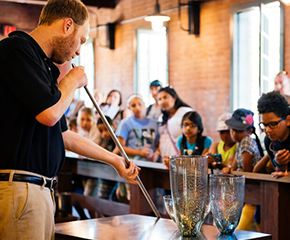In the Great Spinning Room - 104,000 Spindles - Olympian Cotton Mills, Columbia, South Carolina, 1903
Add to SetSummary
Mill owners used the most up-to-date machines in their factories to increase production and cut labor costs, hiring children to tend some of them. A typical child's job was that of spinner, tending 6 or 7 rows of rotating bobbins and watching for breaks in the cotton--then quickly mending them. By 1900, laws in the North limited child labor to an extent, but the practice was widespread in the South, where much of the textile industry had moved.
Mill owners used the most up-to-date machines in their factories to increase production and cut labor costs, hiring children to tend some of them. A typical child's job was that of spinner, tending 6 or 7 rows of rotating bobbins and watching for breaks in the cotton--then quickly mending them. By 1900, laws in the North limited child labor to an extent, but the practice was widespread in the South, where much of the textile industry had moved.
Artifact
Stereograph
Date Made
1903
Subject Date
1903
Creators
Collection Title
Location
Not on exhibit to the public.
Object ID
2020.0.1.76
Credit
From the Collections of The Henry Ford.
Material
Paper (Fiber product)
Technique
Gelatin silver process
Printing (Process)
Color
Gray (Color)
Black-and-white (Colors)
Dimensions
Height: 3.5 in
Width: 7 in





